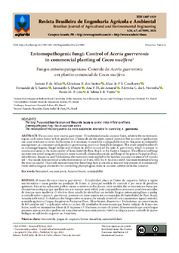Entomopathogenic fungi: Control of Aceria guerreronis in commercial planting of Cocos nucifera.
Entomopathogenic fungi: Control of Aceria guerreronis in commercial planting of Cocos nucifera.
Author(s): ALFAIA, J. P. de; SANTOS, G. R. dos; CAVALCANTE, A. de P. S.; SANTOS, F. de S.; DUARTE, L. S.; AMARAL, A. P. M. do; NORONHA, A. C. da S.; LINS, P. M. P.; VIEIRA, T. F. B.
Summary: The coconut mite (Aceria guerreronis - Eriophyidae) attacks coconut fruits, inhabits the meristematic region, and causes losses in fruit production. Chemicals are the main control measures but successive applications can cause resistance in mites. In this sense, it is necessary to search for ecological alternatives that assist in sustainable management, as consumers seek products grown using more eco-friendly techniques. This study aimed to identify an entomopathogenic fungal isolate and evaluate its ability to control the mite A. guerreronis, which is present in commercial areas in the municipality of Santa Izabel do Pará, Brazil, in the Eastern Amazon. The efficiency of fungi on mites was tested using six treatments: water (control), chemical acaricide, and fungi of the genera Purpureocillium, Metarhizium, Beuaveria, and Trichoderma; the treatments were applied to the bunches at a concentration of 108 conidia mL-1. The results demonstrated a reduction in mites on fruits, with the B. bassiana and P. lilacinum treatments being the most successful. This study demonstrates that these fungi have acaricidal action and may present an economically viable and ecological alternative for controlling phytophagous mites in coconut cultivation in the Amazon./O ácaro do coco (Aceria guerreronis - Eriophyidae) ataca os frutos do coqueiro, habita a região meristemática e causa perdas na produção de frutos. A principal medida de controle é por meio de produtos químicos. Sucessivas aplicações podem causar a resistencia dos ácaros, neste sentido, faz-se necessária a busca por alternativas ecológicas que auxiliem em um manejo sustentável, pois consumidores procuram produtos oriundos de técnicas mais saudáveis. O objetivo deste estudo foi identificar um isolado fúngico entomopatogênico e avaliar o controle sobre o ácaro A. guerreronis, presente em áreas comerciais no município de Santa Izabel do Pará, Brasil, Amazônia Oriental. A eficiência dos fungos sobre os ácaros, foi testada através de seis tratamentos: água (controle), acaricida químico e fungos dos gêneros Purpureocillium, Metarhizium, Beuaveria e Trichoderma, na concentração de 10 8 conídios mL-1 , e aplicados sobre os cachos. Os resultados demonstraram que houve redução de ácaros nos frutos, sendo os tratamentos à base de B. bassiana e P. lilacinum, os mais eficientes, demonstrando que esses fungos possuem ação acaricida e podem ser uma alternativa economicamente viável e ecológica para o controle de ácaros fitófagos no cultivo de coqueiro na Amazônia.
Publication year: 2024
Types of publication: Journal article
Unit: Embrapa Eastern Amazon
Keywords: Biocontrole, Coco, Cocos Nucifera, Fungo, Fungo Entomógeno, Praga, Praga de Planta
Observation
Some of Embrapa's publications are published as ePub files. To read them, use or download one of the following free software options to your computer or mobile device. Android: Google Play Books; IOS: iBooks; Windows and Linux: Calibre.
Access other publications
Access the Agricultural Research Database (BDPA) to consult Embrapa's full library collection and records.
Visit Embrapa Bookstore to purchase books and other publications sold by Embrapa.

